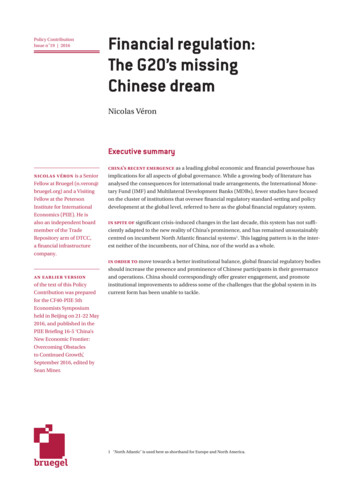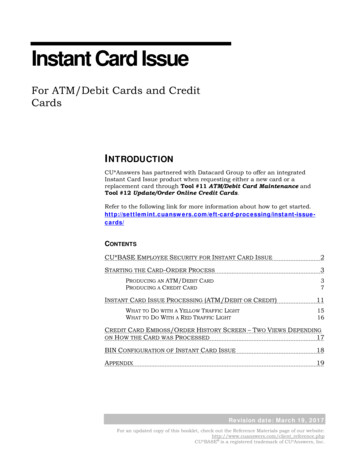
Transcription
Policy ContributionIssue n 19 2016Financial regulation:The G20’s missingChinese dreamNicolas VéronExecutive summaryNicolas Véron is a SeniorFellow at Bruegel (n.veron@bruegel.org) and a VisitingFellow at the PetersonInstitute for InternationalEconomics (PIIE). He isalso an independent boardmember of the TradeRepository arm of DTCC,a financial infrastructurecompany.An earlier versionof the text of this PolicyContribution was preparedfor the CF40-PIIE 5thEconomists Symposiumheld in Beijing on 21-22 May2016, and published in thePIIE Briefing 16-5 ‘China’sNew Economic Frontier:Overcoming Obstaclesto Continued Growth’,September 2016, edited bySean Miner.China’s recent emergence as a leading global economic and financial powerhouse hasimplications for all aspects of global governance. While a growing body of literature hasanalysed the consequences for international trade arrangements, the International Monetary Fund (IMF) and Multilateral Development Banks (MDBs), fewer studies have focusedon the cluster of institutions that oversee financial regulatory standard-setting and policydevelopment at the global level, referred to here as the global financial regulatory system.In spite of significant crisis-induced changes in the last decade, this system has not sufficiently adapted to the new reality of China’s prominence, and has remained unsustainablycentred on incumbent North Atlantic financial systems1. This lagging pattern is in the interest neither of the incumbents, nor of China, nor of the world as a whole.In order to move towards a better institutional balance, global financial regulatory bodiesshould increase the presence and prominence of Chinese participants in their governanceand operations. China should correspondingly offer greater engagement, and promoteinstitutional improvements to address some of the challenges that the global system in itscurrent form has been unable to tackle.1 ‘North Atlantic’ is used here as shorthand for Europe and North America.
The global financial regulatory system:taking stockInternational financial institutions were an innovation of the second quarter of the twentiethcentury. In particular, the Bank for International Settlements (BIS) was created in 1930 andthe IMF was created in 1945. But international arrangements on financial regulatory mattersremained minimal until the early 1970s. At that time, and in the context of incipient internationalisation of financial markets and financial turmoil in advanced economies, severalnew international bodies were created: notably the Euro-currency Standing Committee ofthe BIS (1971), now the Committee on the Global Financial System (CGFS); the InternationalAccounting Standards Committee (1973), now the International Financial Reporting Standards Foundation (IFRS Foundation); the Inter-American Regional Association of securitiesregulatory authorities (1974), expanded in 1983 to become the International Organisation ofSecurities Commissions (IOSCO); the Committee on Banking Regulations and SupervisoryPractices at the BIS (1974), now the Basel Committee on Banking Supervision (BCBS); and theGroup of Six (1975), now the G7. More specialised bodies were created in the 1980s and 1990s,particularly in the wake of the 1997-98 Asian Financial Crisis. That crisis led to the emergenceof the G20, which at that time (1999) was a group of finance ministers and central bank governors, and of the Financial Stability Forum (FSF), also in 1999.Further change and strengthening came in the immediate aftermath of the financialpanic of September-October 2008. In November 2008, the G20 held its first summit meetingof heads of state and government, in Washington DC, with an agenda that was dominated byfinancial regulatory issues (Rottier and Véron, 2010). The FSF was subsequently enlarged toinclude most major emerging economies and non-Western international financial centres, and was renamed the Financial Stability Board (FSB) in April 2009 at the G20’s secondsummit meeting in London. At the subsequent G20 summit, in Pittsburgh in September 2009,the US Treasury Secretary described the FSB and its constituent international financial bodiesas a “fourth pillar” of the global economic architecture, complementing the IMF, the WorldBank and the World Trade Organisation (WTO)2. The Washington, London and Pittsburghmeetings defined an ambitious and, at the global level, unprecedented agenda that has cometo be referred to officially as “G20 financial regulatory reforms” (FSB, 2015b).In this context, the global financial regulatory system can be defined as being formed bythe FSB and its members that have a global (as opposed to national, or in the case of European institutions, regional) remit. In addition to the already mentioned BCBS, BIS, CGFS,IFRS Foundation3, IMF, IOSCO and World Bank, the system thus defined also includes theBIS’s Committee on Payments and Market Infrastructures (CPMI), the International Association of Insurance Supervisors (IAIS) and the Organisation for Economic Co-operation andDevelopment (OECD). Additional relevant bodies, which are not formally members of theFSB but participate in the global system, include the Financial Action Task Force on MoneyLaundering (FATF), Global Legal Entity Identifier Foundation (GLEIF), the InternationalAssociation of Deposit Insurers (IADI) and the International Forum of Independent Audit2 “[T]he important thing we did in London ( ) is to add, in effect, a fourth pillar to the architecture of cooperation weestablished after the second world war. After the second world war, we came together and established the IMF, the WorldBank, the GATT which became the WTO. But the Financial Stability Board is, in effect, a fourth pillar of that architecture.And that forum, just for those of you who are not familiar with it, again brings together central banks, finance ministers,supervisors of banks, market regulators like the SEC and the CFTC, the accounting standard setters – brings them togetherand tries to forge consensus on standards, so we can have, again, common standards applied globally.” Press briefing byUS Treasury Secretary Timothy Geithner on the G20 Meetings, White House, 24 September 2009.3 Formally the membership of the FSB is held by the International Accounting Standards Board (IASB), which ishosted by the IFRS Foundation.2Policy Contribution Issue n 19 2016
Regulators (IFIAR)4. As Table 1 illustrates, these bodies vary widely in terms of membershipand mandate.Table 1: The global financial regulatory systemBodyCreationHQ/SecretariatSummarised mandateJurisdictions aMembers bBIS1930Basel (CH)Central bank cooperation6060IMF1945Washington (US)Financial stability ofcountries189189World Bank1945Washington (US)Development189189OECD1948Paris (FR)Economic sustainability3434CGFS1971Basel (CH)Monitoring marketdevelopments2223IFRS Found.1973London (UK) cFinancial accountingstandardsnot relevant dnot relevant dBCBS1974Basel (CH)Banking supervisorystandards2845IOSCO1974/83Madrid (ES)Securities markets regulation123 e126 eCPMI1980Basel (CH)Financial infrastructurestandards2425FATF1989Paris (FR)Combating the financing ofcrime and terrorism3737IAIS1994Basel (CH)Insurance supervisorystandards195210FSB1999Basel (CH)Financial regulation2568IADI2002Basel (CH)Deposit insurance standards7980IFIAR2006Tokyo (JP)GLEIF2014Basel (CH)fAudit oversight5155Legal entity identifiersnot relevant dnot relevant dSource: Bruegel based on institutions’ websites, consulted May 2016. See main text for the explanation of acronyms. Notes: a Jurisdictions include sub-sovereign entities (eg Guernsey, Hong Kong SAR, or US states and territories) and regional groupings (such as theEuropean Union). b There is one member per jurisdiction at the BIS, IMF, World Bank and OECD. In other bodies, some jurisdictions haveseveral members, such as the US Federal Reserve Board and Federal Reserve Bank of New York in the CGFS and CPMI. Global institutionssuch as the IMF and World Bank are members of bodies such as the FSB and IAIS, but are not counted as separate jurisdictions. c The IFRSFoundation is incorporated in the United States (Delaware), but its operations are almost entirely in London. d The IFRS Foundation andGLEIF are not organised across jurisdictional lines. e Only ordinary members. f The establishment of a permanent secretariat in Tokyo wasannounced by IFIAR in late April 2016, and is expected in 2017. NB The People’s Republic of China is a member of all jurisdiction-basedbodies except IADI and IFIAR.Eight years on from the Washington Summit, the G20 financial regulatory reforms can bejudged as having mixed results. Assessing the success of financial reforms is always somewhatjudgmental to start with, as there is no objective way (yet?) to measure financial stability. Furthermore, many of the reforms entail long transition periods and have thus not yet been fullyimplemented. There have been a number of successes (see also GAO, 2014; Véron, 2014). Inparticular, the BCBS’s Basel III accord of 2010, with new rules for capital, leverage and liquidity, and complementary reforms such as requirements for additional loss-absorbing capacityat large financial institutions designated by the FSB as Global Systemically Important Banks(G-SIBs; see FSB, 2015a), have significantly strengthened the prudential framework for large4 Other potentially relevant organisations, such as the International Auditing and Assurance Standards Board(IAASB) and the International Public Sector Accounting Standards Board (IPSASB), both hosted by the InternationalFederation of Accountants, are not included in the list because their standards have not yet been adopted by a criticalmass of jurisdictions. Coordinating committees and other groups that don’t have a permanent secretariat, includingthe G20 itself, are also not included.3Policy Contribution Issue n 19 2016
internationally active banks. The BCBS has also developed a pioneering framework to assessto what extent the laws and regulations adopted by individual jurisdictions are compliantwith its standards, thus greatly enhancing its authoritativeness5.Other reforms have had questionable impact, or have failed entirely. One failed reformwas the global convergence of financial accounting standards, initially heralded by the G20as an important objective but later quietly abandoned after several successive deadlineswere missed6. The implementation of the G20’s ambitious reforms of over-the-counter (OTC)derivatives markets has been delayed in many jurisdictions, and it is therefore too early toassess its full impact. Specifically, the G20-fostered move towards more central clearing isleading to the concentration of systemic risk in derivatives central counterparties (CCPs) orclearing houses (eg Boissel et al, 2016), creating new forms of systemic risk which in turn callfor policy responses still to come, and may also lead to initially unintended market fragmentation across currency areas. Separately, the reporting of OTC derivatives transactions to traderepositories is still far from fully delivering on its promise to help supervisors assess developments of relevance for financial stability (DTCC, 2015).Perhaps unsurprisingly, the success or lack thereof of G20 financial regulatory reformsis strongly correlated with the strength of the corresponding global institutional framework(Rottier and Véron, 2010). In particular, the long-established cooperation between the world’smain central banks through the BIS and its various committees has generally resulted indecent effectiveness of reforms within their remit, such as Basel III. By contrast, cooperationbetween securities regulators is of a more ad-hoc nature, and IOSCO has generally foundit difficult to agree on strong common standards and ensure their general adoption, as isillustrated by the G20’s failure on financial accounting standards convergence7. One of thereasons why the design and implementation of OTC derivatives reforms have been so lopsided is because there is an awkward overlap of responsibilities in this area between centralbanks with a financial stability mandate (represented in CPMI) and securities regulators witha market integrity mandate (represented in IOSCO). Some standards have been jointly issuedby CPMI and IOSCO (eg Principles for Financial Market Infrastructures, first published inApril 2012), but they have often been less specific and/or effective than global standards inother financial regulatory areas.5 See successive Regulatory Consistency Assessment Programme reports published by the BCBS. Under thisprogramme, the People’s Republic of China was assessed in 2013 as ‘compliant,’ while in 2014 the United States was‘largely compliant’ and the European Union ‘materially non-compliant.’6 The People’s Republic of China still maintains its own set of accounting standards, and (unlike eg Japan) does notallow the use of IFRS by listed companies as an alternative to its national standards. Local accounting standards inHong Kong SAR, though not in Macao SAR, are identical to IFRS. The United States allows IFRS as an alternative to itsnational standards for foreign issuers, but not for domestic ones. The European Union has endorsed all IFRS standardsas domestic law, with the only exception of a limited ‘carve-out’ in the standard for financial instruments. Overall,a majority of the world’s sovereign jurisdictions, representing close to half of global GDP, have mandated IFRS forpublicly listed companies. Most of the corresponding policy decisions were made in the decade before the first G20summit (Pacter, 2015, and own calculations).7 Choices of mandatory accounting standards are typically, though not universally, within the scope of responsibilityof securities market regulators.4Policy Contribution Issue n 19 2016
The global financial regulatory systemretains North Atlantic characteristicsThe panic of September-October 2008 led to a welcome shift of venue from the G7 to the G20for the global coordination of economic and financial policy. This shift was echoed in early2009 by the enlargement to major emerging economies and non-Western financial centres ofthe membership of the FSB (succeeding the FSF) and of several key BIS committees includingthe BCBS, CGFS and CPMI.Nevertheless, the membership and governance of many of the bodies that form the globalfinancial regulatory system remains deeply unbalanced. There is abundant analysis of thisissue with respect to the IMF (eg Truman, 2015). Similar and sometimes even greater distortions exist in other bodies. For example, even after the 2009 enlargement, European Union(EU) member states, plus the EU itself, represent no fewer than 10 of the 28 jurisdictionsrepresented in the BCBS. Of these, seven are euro-area countries whose representation in theCommittee no longer appears justified, since the European Central Bank (ECB) has been incharge of setting supervisory policy for the entire euro area since November 2014, as part ofthe broader EU reform known as banking union8.Similarly, Europeans are overrepresented in the FSB’s Steering Committee (FSB, 2015d),both among the member jurisdictions (especially those with more than one representative,and with similarly questionable inclusion of euro-area national central banks as noted aboveabout the BCBS9) and among the global bodies, whose 10 representatives include 8 Europeans, one American, one Australian, and no Asian at all.10The system’s North Atlantic bias is even more pronounced, indeed overwhelming,when looking at the bodies’ leaderships, as opposed to memberships. Table 2 illustratesthis by listing all top positions in the bodies mentioned in Table 1, including the chairs ofdecision-making bodies (such as an executive board) and heads of permanent staff, whereseparate. The right-hand column does not require much comment.Moreover, another distortion inherited from history is that, as Table 1 indicates,all these bodies are also headquartered and mainly based in the North Atlantic region(Basel, Paris, Madrid, London and Washington DC), with the only exception being IFIAR’sstill-to-be-established secretariat in Tokyo11.Thus, the global financial regulatory system retains a North Atlantic bias in its governanceand operations that has only been very partly eroded by initiatives since 2007. A separatequestion, however, is whether this bias results in regulatory outcomes and decisions that aretilted in favour of North Atlantic interests. On this, the evidence is far from clear. While theG20 has regularly paid lip-service to the notion that regulatory outcomes need to be bettertailored to the specificities of developing and emerging economies, this aspiration has mostlybeen rhetorical rather than practical. There is no clear case, for example, that Basel III isless beneficial to emerging economies than it is to the European Union or the United States.Moreover, there are also cases of successful advocacy by non-Western jurisdictions of specialinterests in global financial regulatory processes: examples include the exception made by theIASB for long-held shares from fair-value measurement in the IFRS 9 standard on financialinstruments accounting, which was a Japanese request, and the exception made for large8 The ECB and its banking supervisory arm became full members of the BCBS shortly before this transition, inOctober 2014.9 National central banks in the euro area retain policy autonomy in several areas including macro-prudential policies, but no longer in either monetary policy or banking supervision.10 In this calculation, Mark Carney is labelled as from the EU in his capacity as Governor of the Bank of England,even though he is a Canadian National.11 Several of the bodies have regional offices that complement their North Atlantic headquarters. For example, theBIS has an office in Hong Kong (and another one in Mexico City); the IMF and World Bank have offices in numerouslocations worldwide; the IFRS Foundation has a small office in Tokyo.5Policy Contribution Issue n 19 2016
banks from emerging economies in the FSB’s term sheet for Total Loss-Absorbing Capacity(TLAC), a request made in particular by China (FSB, 2015c).Table 2: Leadership positions in the global financial regulatory systemPositionHolderWorkloadNationalityRegionBoard ChairmanJens WeidmannPart timeGermanNorth AtlanticBodyBISIMFGeneral ManagerJaime CaruanaFull timeSpanishNorth AtlanticManaging DirectorChristine LagardeFull timeFrenchNorth AtlanticPresidentJim Yong KimFull timeAmericanNorth AtlanticSecretary GeneralAngel GurriaFull timeMexicanNorth AtlanticWorld BankOECDCGFSIFRSFoundationChairWilliam DudleyPart timeAmericanNorth AtlanticHead of SecretariatKostas TsatsaronisFull timeGreekNorth AtlanticChair of TrusteesMichel PradaPart timeFrenchNorth AtlanticIASB ChairHans HoogervorstFull timeDutchNorth AtlanticMario DraghiPart timeItalianNorth AtlanticChairStefan IngvesPart timeSwedishNorth AtlanticSecretary GeneralWilliam CoenFull timeAmericanNorth AtlanticBoard ChairmanAshley Ian AlderPart timeBritishNorth AtlanticChair GHOSBCBSIOSCOCPMIFATFIAISFSBIADIIFIARbSecretary GeneralPaul AndrewsFull timeAmericanNorth AtlanticChairBenoit CoeuréPart timeFrenchNorth AtlanticHead of SecretariatMorten BechFull timeDanishNorth AtlanticPresidentJ.M. Vega-SerranoPart timeSpanishNorth AtlanticExecutive SecretaryDavid LewisFull timeBritishNorth AtlanticExec. Committee ChairVictoria SaportaPart timeBritishNorth AtlanticSecretary GeneralYoshihiro KawaiFull timeJapaneseOtherChairMark CarneyPart timeCanadianNorth AtlanticSecretary GeneralSvein AndresenFull timeNorwegianNorth AtlanticPresidentThomas HoenigPart timeAmericanNorth AtlanticSecretary GeneralGail VerleyFull timeAmericanNorth AtlanticChairJanine van DiggelenPart timeDutchNorth AtlanticBoard ChairmanGerard HartsinkPart timeDutchNorth AtlanticCEOStephan WolfFull timeGermanNorth AtlanticcGLEIFaSource: Bruegel based on institutions’ websites, consulted July 2016. See main text for the explanation of acronyms. Notes:aGHOS: Group of Governors and Heads of Supervision. b Mr Adler heads the Hong Kong Securities & Finance Commission,but is a British citizen. c The head of IFIAR’s future permanent secretariat has not at the time of writing been appointed.Even so, the extent of the system’s North Atlantic bias, more than seven years after the shiftfrom G7 to G20, remains remarkable. There is no question that the willingness of incumbentparticipants, especially Europeans, to preserve a status quo that they perceive as beneficial tothem is one of the reasons for this situation. But the lack of change is probably not attributableonly to resistance from incumbents. Evidence is missing of any strong advocacy for rebalancing coming from the other stakeholders, especially large emerging economies, many of which– including often China – have acted as status-quo participants, in financial regulatory matters (Walter, 2010; He, 2015) and more generally on global governance reform (Swaine, 2016).Instead, the evidence rather points to China taking global financial regulatory standards ‘off theshelf’ for use as a lever for domestic financial reform (Kempthorne, 2015), similarly to what wasoften the case in the EU before the crisis, for example in its adoption of IFRS in the early 2000s(Véron, 2007).6Policy Contribution Issue n 19 2016
The global financial regulatory systemneeds a Chinese dreamThe state of affairs described in the previous section might be acceptable if the North Atlanticregion was expected to dominate the global financial system for the foreseeable future. Butthis is no longer a valid assumption. The pace of financial development in China has been sorapid in the last few years that, on some indicators, the move of the global system’s centre ofgravity towards China has already happened. For example, and as Table 3 illustrates, China isnow the world’s largest single banking jurisdiction in terms of total assets, ahead of the euroarea, a fact that few would have predicted only a decade ago. This is even more striking whenkeeping in mind that ‘shadow banking’ assets are mostly excluded from this calculation12.Table 3: Banking systems in comparative perspective, end-2015Total assets(US trillion)Domesticassets(US trillion)Foreignassets(US trillion)China32.130.71.4Euro area31.625.95.7United States16.314.81.5Banking systemSource: Schoenmaker and Véron (2016). Calculations based on SNL data and ECB (2016b) for the euro area, China Banking RegulatoryCommission (CBRC) for China, and Federal Reserve for the United States. Notes: total assets comprise consolidated assets of domesticbanking groups and domestic assets of subsidiaries and branches of foreign banks. To calculate the size of the respective banking system (labelled as domestic assets), the foreign assets of domestic banks are deducted. The concentration ratio of the largest five banks(CR-5) is based on their domestic assets as percentage of total domestic assets.China’s increasing heft in the global financial system is not limited to banking. Theaggregate market capitalisation of its listed companies has become too large to ignore, ashas the size of its corporate bond markets. Furthermore, China’s financial developmentshould not be seen only from a quantitative standpoint. While capital allocation remainslargely policy-driven, there have been significant moves towards more market discipline inrecent years, including liberalisation of bank deposit rates and the more recent willingnessof the authorities to tolerate corporate defaults even of state-owned companies. One alsoassumes that lessons from the massive government intervention in China’s equity marketsaround mid-2015 will lead to a more restrained future stance in this area as well, allowingequity prices to be increasingly driven by the interplay of supply and demand. It is alsounlikely that the recent dramatic rise in indicators such as China’s share of global bankingassets or of global market capitalisation could be entirely reversed by future adverse marketdevelopments. Even in a scenario of systemic crisis, the evidence from past experiencesuggests that total banking assets would stop growing but would remain broadly at theircurrent high level over an extended period of time13.Furthermore, China’s financial system will most likely become increasingly interconnected with the rest of the global financial system. Size is a major driver of this: even ifthe Chinese banking system is less open to cross-border activity than the systems of otherjurisdictions (as also illustrated by Table 3), its sheer magnitude implies global systemic12 Banking systems are defined here by the geographical scope of banking supervision. Under this definition, theeuro area is now a single banking system, while different banking systems coexist in the European Union.13 Such a ‘plateauing’ pattern was observed, among other cases and with limited variations, in Japan after 1990 andin the euro area, the UK and the US after 2008.7Policy Contribution Issue n 19 2016
significance. Furthermore, Chinese banks are increasingly active outside mainland China,together with non-financial companies driven both by individual firm strategies and by policyprojects such as the Belt and Road Initiative. Meanwhile, Chinese authorities are graduallylifting restrictions on international investors’ access to its domestic equity and bond markets,including the Shanghai-Hong Kong Stock Connect, started in 2014, and the forthcomingShenzhen-Hong Kong Stock Connect. International financial integration is gradually linkingChina together with other countries like a financial ‘Grand Canal’ that interconnects differenteconomies, fosters cross-border interdependencies and increases aggregate wealth, but canalso be a channel for the propagation of shocks – very much as China’s own Grand Canal haslinked its provinces together since ancient times14.China is also, and increasingly, at the frontier of some aspects of contemporary financialdevelopment, ahead of North Atlantic jurisdictions. This is particularly the case for internet- and smartphone-enabled financial services business models (referred to in China asinternet finance), several segments of which are more developed in China than in Europeor the United States. Internet finance, like cross-border financial integration, illustrates thereality that with financial development comes great wealth creation but also the possibilityof increased financial disruption, including the risks of fraud, cybersecurity violations anduncontrolled herd behaviour in a market downturn.For all these reasons, the current fairly peripheral (or at best, discreet) role of China in theglobal financial regulatory system is increasingly problematic. The system needs a guidingvision in which China becomes much more central – a ‘Chinese dream.’ The system’s (largelyNorth Atlantic) protagonists should not count only on China’s initiatives aimed at increasing itsown salience in global financial-services policy discussions, but should rather be proactive inintroducing reforms that give China a position and responsibility commensurate with its present and predictable future importance. Not doing so will increasingly carry risks for all stakeholders involved, such as being caught unprepared by a globally relevant materialisation of risksthat involve Chinese financial system participants among others. A foot-dragging approach,encapsulated in the Chinese expression yu guo ji jie gui (与国际接轨, ‘catching up with theworld’ – see He, 2015), will not be sufficient to address this challenge. Front-loading the rise ofChina in global finance in the global financial regulatory infrastructure is evidently a challenging political proposition, for different reasons in Europe (collectively the most overrepresentedincumbent), in the United States (given domestic political dynamics at the time of writing) andperhaps even in China itself. But there is little doubt that it would ultimately be in the best interest of the North Atlantic jurisdictions, as well as of China and of the rest of the world.Making the dream come trueThe vision of a global financial regulatory system in which China holds a major position canof course not be realised in one single step. It may entail at least three clusters of initiatives, tobe developed and implemented over an extended period.First, the relevant global bodies should reform themselves to increase the presence andprominence of Chinese participants in their operations, and specifically in their membership, leadership and location. As for membership, national central banks from the euroarea, which in the aftermath of banking union no longer have significant policymakingautonomy, should renounce their individual representation in the Basel Committee forBanking Supervision and in the Financial Stability Board, thus freeing space for a more bal-14 The author is indebted to Professor He Liping of Beijing Normal University for the Grand Canal metaphor ofcross-border financial integration.8Policy Contribution Issue n 19 2016
anced discussion in a more compact format; conversely, the FSB should welcome the ChinaSecurities Regulatory Commission (CSRC) as an additional member organisation, perhapstogether with the US Financial Deposit Insurance Corporation (FDIC); and China’s quota atthe IMF should further increase beyond the implementation of the 2010 reform package15.As for leadership, relevant global financial regulatory bodies should promote qualifiedChinese officials to succeed the current North Atlantic incumbents when their terms expire(see Table 2), and should actively nurture a growing cadre of Chinese professionals amongtheir staff. As for location, further steps should be envisaged to rebalance the current landscape, including the relocation of the FSB’s permanent secretariat to a suitable jurisdictionin Asia, eg Hong Kong or Singapore (Véron, 2014).Second
International financial institutions were an innovation of the second quarter of the twentieth century. In particular, the Bank for International Settlements (BIS) was created in 1930 and . At the subsequent G20 summit, in Pittsburgh in September 2009, . BIS's Committee on Payments and Market Infrastructures (CPMI), the International .











